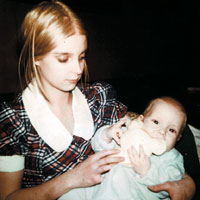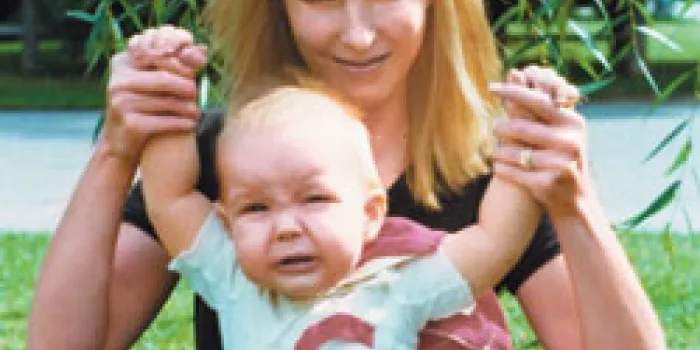Connie McMullan’s kitchen is a testament to the things she holds dear: a collection of stuffed bears, glass angels that sparkle in the sun and a refrigerator covered with snapshots of her children and grandchildren. But a blue album holds photos of what she can no longer touch: her deceased daughter, Doreen. “She was an iron butterfly. She had a strong will and determination,” says the 77-year-old widow, who lives in Huntington Station, on Long Island in New York.
Doreen died in 1979 from complications of a gastrointestinal bleed, a result of von Willebrand disease (possibly type 3, the most severe form), not adequately treated at the time. More than 30 years later, it’s still painful for Connie to talk about it. At the time, Doreen was 25 years old, married and enjoying being home with Jamie, her 5-year-old son.
These days, most families in the US will never lose a loved one to a bleeding disorder. Better treatments, in the form of clotting factors and products that promote clotting, have lowered the incidence of death dramatically. Further, comprehensive care is now provided through a national network of hemophilia treatment centers (HTCs). But families can empathize with the McMullans’ experience living with a family member who has an undiagnosed or misdiagnosed bleeding disorder and the complications that can result.
The McMullans Become a Family

Connie married Patrick McMullan, a Korean War veteran, in 1952. They settled in Brooklyn, where Doreen was born in 1953. Two years later, Patrick joined the family. Sharon was born in 1963.
“Doreen was a beautiful, healthy baby,” says Connie. Once she was able to eat solid foods, however, Doreen had frequent episodes of projectile vomiting. “She would throw up 30 or 40 times,” even after eating plain foods like oatmeal or applesauce, Connie says. Two years of intermittent episodes caused Connie’s concern to deepen. “I told the doctor, ‘Something isn’t right.’ ” During one of the bouts, Connie ran six blocks to the doctor’s office with Doreen in her arms. Seeing it for himself, the doctor was astonished. “Why didn’t you tell me how bad she was?” he asked.
Doreen was diagnosed with pyloric stenosis, a narrowing of the outlet of the stomach, which prevents the passage of food into the small intestines. A surgeon at St. Catherine’s Children’s Hospital in Brooklyn operated on the 2-year-old, creating an artificial opening to connect the stomach to the intestines, relieving the blockage. By the time Doreen left the hospital six weeks later, she weighed only 10 pounds. “The doctors told us to try to get her to eat and learn to walk again,” Connie says. “They warned us that we’d make her an invalid the rest of her life if we didn’t make her try to do things.”
A Brother’s Love
Raising two children two years apart meant they were constant companions. When Doreen was 6 and Patrick was 4, he overheard his sister moaning in the middle of the night. “He got up from his bed and saw her lying on the bathroom floor,” Connie says. Patrick alerted his parents. “She was bleeding through her nose, her mouth, her rectum,” Connie says. With no previous bleeding episodes, the incident was bewildering. “I couldn’t imagine what had happened,” says Connie. “I asked myself, ‘What could have caused this?’ ”
Doreen was rushed to the hospital by ambulance. Stanching the flow of blood proved difficult. “They couldn’t stop the bleeding. Every time they would give her blood, she would lose it,” Connie says. “She had at least 16 blood transfusions.”
The artificial opening from the previous surgery had allowed stomach acids to create bleeding ulcers. This time the surgeon recommended a complete resection of Doreen’s stomach, with a natural opening to the intestines. The recovery took months. Doreen returned to her first-grade classroom right before the school year ended in June.
Patrick had witnessed all the fuss people were making over his sister. “She’s getting all this attention.
Everybody wants to know how she’s doing,’ ” Connie remembers Patrick saying. But Patrick was the unsung hero. “He saved her life,” Connie says. “The doctor said if he hadn’t found her, she would not have made it. Thank God, as a little boy, he knew what to do.”
Bleeding Symptoms Surface
Like other girls her age, Doreen was active. “Although she was delicate, she didn’t act delicate,” her mom recalls. She played volleyball, danced and had friends over. “They were always playing with Barbie dolls,” Connie says. Unlike the other girls, however, often there was a price to pay. “I noticed when she was 7 or 8 years old, if she was playing, fell off the slide, tripped or banged her elbow, she’d have bruises,” says Connie. Her pediatrician suspected leukemia, but the test results were negative.

Still, the bruising was bad. Physicians would ask Doreen, “Who gave you the bruise on your arm?” She would reply, “Well, my mother grabbed me to get me to come back in the house.” It was the accusations from people in public, though, that were harder to endure. “Are you hurting that child?” people would ask Connie. She would reply vehemently, “My God, no.” No one could account for the bruises Doreen so frequently sported.
One bad bleed from a fall on the playground caused a swollen knee. “I thought it was water and wondered how it could fill up so fast,” Connie recalls. But it wasn’t water; it was blood. “After they drained it, they kept saying everything was fine and they didn’t understand it.”
The teenage years brought a new set of problems for Doreen—erratic menstrual cycles. “She always had difficulty with her periods,” says Connie. “It seems she always had bleeding because her cycle wouldn’t end.” One doctor warned Doreen about becoming pregnant. “I think it’s going to be very difficult for you to ever have a child,” he said.
The Nurse Who Knows What It’s Like
In high school, Doreen made her career decision: She was going into nursing. Connie was surprised. “But you’ve been in the hospital so much,” Connie told her. Doreen would not be deterred. “I know what it’s like to be a patient,” she told her mother. “I want to be the nurse who knows what it’s like.” (Read about other young people with bleeding disorders pursuing healthcare careers.)
Once the family was convinced, the next obstacle was convincing the faculty. “The nursing school did not want to accept her because they said she was so frail.” But Doreen persevered, and she was accepted.
During Doreen’s second year at the Long Island College Hospital School of Nursing in Brooklyn, one of her instructors noticed her bruises. He was a doctor and asked Doreen’s permission to run a series of tests, comparing her blood with that of another nursing student. “He discovered she had von Willebrand disease,” says Connie. “He told her it was like being a female with hemophilia.” Doreen’s family then went to school themselves. “We knew nothing about it. We tried to read everything we could find,” says Connie. There was no history of bleeding disorders in the McMullan family.

In 1973, Doreen graduated from nursing school and got married. She had fallen in love with Robert McCarthy, who was two years older. The couple moved to an apartment in Brooklyn, and Doreen was hired as a nurse at Coney Island Hospital. Six months later, while visiting Doreen’s parents, the couple teased each other about Doreen’s need for naps. “You could be pregnant,” Connie told her. Doreen replied, “Oh, Mom, you know I probably won’t ever be able to have a child. Well, not this quickly, anyway.”
But Connie was persistent. She took Doreen to her doctor. “He came out of the room and said, ‘You’re going to be a grandma,’ ” Connie says. Instead of feeling elated, however, the family was anxious. “We were very shocked. We were worried that she couldn’t carry a baby.”
Because Doreen was in a high-risk category, she received special care throughout the pregnancy. Although she hemorrhaged during the birth and needed blood transfusions, she delivered a healthy baby. On January 30, 1974, Jamie Michael McCarthy was born. “They checked the baby for everything. He was perfectly healthy,” Connie says.
Because of her fragile health and her bleeding and bruising episodes, Doreen decided not to return to nursing. She stayed home to raise her son. “She was absolutely very, very happy,” says Connie. Jamie had five good years with his mother.
One day in the spring of 1979, Doreen went to her doctor for flulike symptoms, including a chill so bad she didn’t take off her coat in the examination room. The doctor sent her home, telling her to drink some hot tea and go to bed. By the time the McCarthys returned home, Doreen was getting worse. Walking up and down the flights of stairs in the apartment had exacerbated her condition. She told Robert, “I’m losing my vision altogether. Something is happening, and you’ve got to get me to the hospital.”
Robert called his in-laws. “Doreen’s in the hospital,” he said. “You’ve got to get to Brooklyn right away. They don’t know if she’s going to make it.” By the time Doreen was rushed to the hospital, she had lost close to 90% of her blood volume, says Connie. By the time her parents arrived, Doreen was unconscious, hooked up to machines that were keeping her alive. “The doctor said they weren’t sure, but they thought she must have had an internal hemorrhage—that she’d been losing blood for a week or two.” Doreen must have dismissed the symptoms, says her mom.

“They were giving her blood. They were hoping against hope,” Connie says. The family was told that Doreen was brain dead. One doctor said, “If God takes her, it’s a blessing.” “For a doctor to say that, well, we were kind of surprised,” Connie says. Doreen died on March 12, 1979.
Coming to Grips with Grief
With all that Doreen had been through, her family expected her to pull through this time. “I kept thinking she had dealt with so many things, but she always recovered,” Connie says. The grief was overwhelming. “I told my family doctor, ‘I just can’t go on.’ But he said, “You have to go on. You have other children. Who’s going to take care of them if you’re not there?”
Connie also had Jamie to nurture. “My parish priest said, ‘Keep in touch. Make sure you see him grow up. Don’t lose contact with him.’ ”
More than 30 years later, Connie has stayed close to her oldest grandson. Only recently have they been able to talk about Doreen. Now they share memorabilia, including Doreen’s elementary school papers. “He got such a kick out of that,” says Connie. “I see Doreen in him so much—in his smile, in the dimple on the side of his face, in his sweet attitude.”
Jamie also takes after his uncle. “Jamie’s a famous photographer. Here’s a picture of him standing next to Donald Rumsfeld,” Connie says, pointing to her refrigerator. He learned the tools of the trade from Patrick, who owns a photo agency in New York City. (See sidebar, “Turning Anger into Advocacy.”)
Over the years, Connie has shared her sorrows with others. For years she helped with a bereavement support group at her church. But she has also shared her joys. “A friend told me, ‘Don’t celebrate the day she died—celebrate the day she was born.’ ” That’s what photo albums are for.


 When Patrick McMullan looks through his camera lens, he sees society people, fashion models and celebrities—the backbone of his business as a nightlife photographer in New York City. But there’s one image he’ll never capture again—that of his sister Doreen. She died of complications of a gastrointestinal bleed in 1979, a year before Patrick opened his photo agency. Doreen was 25 and Patrick was 23.
When Patrick McMullan looks through his camera lens, he sees society people, fashion models and celebrities—the backbone of his business as a nightlife photographer in New York City. But there’s one image he’ll never capture again—that of his sister Doreen. She died of complications of a gastrointestinal bleed in 1979, a year before Patrick opened his photo agency. Doreen was 25 and Patrick was 23.